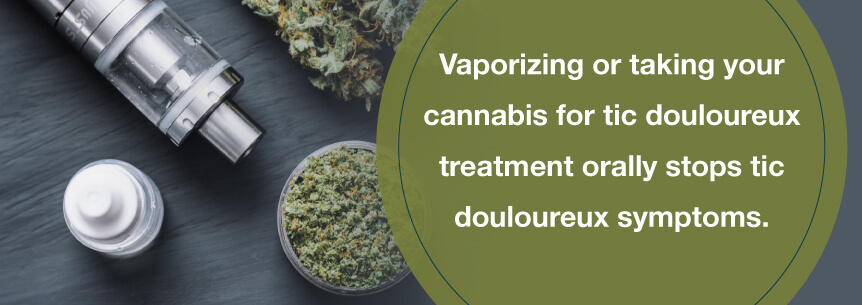
Tic douloureux is one of the rarest health conditions in the world. Learn what the disorder is and in what physicians can do to treat it today, including using medical marijuana for tic douloureux.
Tic douloureux is a chronic condition, which is also known as trigeminal neuralgia, trifacial neuralgia, Fothergill Disease or simply TN. People who suffer from it experience a severe and stabbing pain in one side of their face. The shooting pain comes from the trigeminal nerve, which is a branch of nerves that provide sensation to the face.
The pain from tic douloureux can last for several seconds to several minutes. During the time people experience the pain, they may wince involuntarily or develop a tic on the side of the face, hence the condition’s name.
As painful as tic douloureux is, it is not a lethal health condition. It also poses no risk to the nerves in the face or the sufferer’s sensory capabilities. It does not rob a sufferer of his or her ability to use other senses, either. You will still feel, taste, hear, smell and see normally.
Nonetheless, this condition is so debilitating that sufferers often fear another trigeminal neuralgia attack. They may avoid normal everyday activities like eating, talking, or even touching their faces out of fear of triggering another attack.
Alternatively, some sufferers go for months without experiencing a trigeminal neuralgia episode. Doctors do not understand why some people experience these painful attacks more often than others. However, they do know this condition appears most often in people who are age 50 to 70 years of age, as well as individuals who suffer from multiple sclerosis. Up to eight percent of patients with multiple sclerosis end up developing trigeminal neuralgia because of MS-associated nerve damage.
Tic douloureux presents itself through a variety of symptoms, including:
The underlying cause for tic douloureux remains a mystery to doctors. They do not know what exactly triggers the painful attacks from this chronic condition.
However, they speculate it may be caused by blood vessels becoming irritated because of illness, blunt force trauma to the face or illnesses like MS. They also suspect the pain may stem from the wearing down of the myelin sheath, or the covering protecting the nerves in the face. Without the myelin sheath to protect them, the nerves are more prone to irritation and pain impulses sent from the brain.
Doctors have identified two forms of tic douloureux, Type 1 and Type 2. Type 1 is associated with the severest forms of pain found with this illness. People with Type 1 TN suffer from intense, stabbing pain around their mouths, noses, cheeks, eyes and other parts of their faces:
The pain from either can be so debilitating people are afraid to live out their everyday routines for fear of triggering another attack.
Researchers don’t know precisely why some people develop one type of this disease over the other or even why some people develop both types of tic douloureux. At this point, doctors are confident the type of TN that people develop will depend on the severity of the nerve compression in the side of their faces.
The effects of tic douloureux on a sufferer’s life can be debilitating and overwhelmingly negative. People who have this condition often become afraid of suffering attacks of pain. They may avoid simple everyday tasks like eating, talking or brushing their teeth out of fear of triggering pain from this illness.
They also may become more reclusive and avoid interacting with others for fear of suffering pain in public. This illness can negatively impact their confidence and compel them to remain shut in at home even though their condition does not result in any permanent harm to their sensory capabilities.
Doctors are not sure of the exact number of people who suffer from this illness. Physicians diagnose around 10,000 to 15,000 new cases of TN each year.

While this illness affects people over the age of 50 most often, it can afflict people of any age, even children. It can also cause related disorders such as:
Doctors use some different methods to treat tic douloureux. They often start a patient’s treatment with drug therapy. They may prescribe either anti-psychotic or anti-convulsant medications to prevent future TN attacks. Some of the most common medicines in these categories include Tegretol, Trileptal, Lamictal and Orap.

Alternatively, doctors may prescribe muscle relaxants like Baclofen or opioids to relax the nerves in the face and prevent episodes of pain. When medications fail to address the symptoms of Tic Douloureux, doctors may perform surgery on the trigeminal nerve. The surgery typically entails injecting an anesthetic directly into the nerve branches.
Some promising mostly non-invasive therapies for tic douloureux include:
Abrupt, one-sided pain lasting from minutes to hours characterizes tic douloureux pain. The type of pain is typically:
Mild stimuli can initiate attacks. These mild stimuli may include:
While antiepileptic drug treatment can help treat those suffering from trigeminal neuralgia, many individuals become intolerant to these drugs. And, presently, there are only a few effective medications for treating the condition.
Today, there’s an increasing amount of research and evidence suggesting cannabis’s psychoactive ingredient and individual cannabinoids could effectively alleviate hyperalgesia and neuropathic pain.

Studies suggest cannabinoids could be beneficial in modulating pain by restricting neuronal transmission in pain pathways. And, considering the distinct pain-blocking effects of cannabinoids produce, they might be a potential treatment option for managing trigeminal neuralgia or tic douloureux.
CBD works as an anti-oxidant and protects nerve cells. CBD and THC together combat pain. Cannabichromene (CBC) is another cannabinoid capable of working as an anti-inflammatory contributing to the medical marijuana’s pain-relieving effects.
Research that has focused on medical marijuana and tic douloureux treatment, more so CBD, have found either the CB1 receptor by itself or combined with the CB2 receptors is what causes the cannabinoids’ anti-neuralgic effects. More evidence suggests activating the CB2 receptor alone could be enough to mediate these anti neuralgic-effects.
In rat models, a new CB2 receptor agonist seems to reduce pain effectively (neuropathic and a few other types of pain) while not affecting motor skills. Both anecdotally in humans and animal tests, cannabinoids have proven to be effective medical cannabis for tic douloureux treatment option.
Sativas are high in cannabidiols and show more stimulating psychological effects and greater immune-enhancing abilities.
Indicas are high in cannabinols and show more relaxing and narcotic effects, providing stronger pain relief.
Tic douloureux tends to present symptoms such as:
Therefore, marijuana and tic douloureux strains to look for would likely be those with the ability to relieve pain and muscle spasms, as well as those for well-being to tackle depression or anxiety you’re experiencing due to your condition.
Some of the best medical marijuana strains for managing pain include:
Medical cannabis strains that are ideal for muscle spasm relief are:
These strains can help promote a feeling of well-being:
When it comes to the delivery method you choose for your medical marijuana and tic douloureux treatment, you have many options. Knowing which method is the “best” can be difficult since there’s always a new method popping up all the time.
The oldest practice is smoking, but more and more people are starting to worry about the potential damage it can do to the lungs. Vaporizing, however, is becoming as well. You can still “inhale” your weed, but don’t get the harmful effects of smoking could bring on.

Vaporizing or taking your cannabis for tic douloureux treatment orally stops tic douloureux symptoms. Vaporizing medical weed tends to hit your system the quickest. Marinol (marijuana synthetic) can take up to an hour for you to feel its full effects.
Other medical marijuana for tic douloureux delivery methods include:
Like with any condition or illness, you’ll want to consult with a trained, cannabis doctor regarding your cannabis and tic douloureux treatment plan. They can go over any possible side effects and address any concerns you have during the process of determining your ideal cannabis treatment plan.
For more help with cannabis and tic douloureux, search for a qualified physician and book your appointment today with MarijuanaDoctors.com. Here you’ll have access to more information on cannabis, a list of qualified weed doctors and a list of dispensaries. Helpful resources you need for your marijuana for tic douloureux treatment will be right at your fingertips at MarijuanaDoctors.com.
Find A Doctor Find A Dispensary